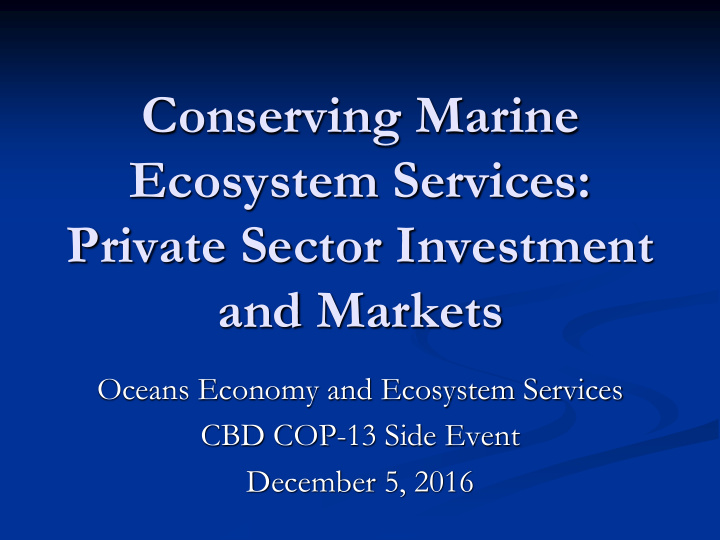



Conserving Marine Ecosystem Services: Private Sector Investment and Markets Oceans Economy and Ecosystem Services CBD COP-13 Side Event December 5, 2016
State of the Oceans and Marine Biodiversity
Many people know about degradation of the oceans, but few realize how this affects all of us… Greater than ever awareness of environmental problems, Scientific consensus on global issues like climate change but… The public remains unaware of the severity of threats: Many ecosystems nearing their tipping points, with implications for human well-being worldwide
Millennium Ecosystem Assessment This five year assessment involved over 1300 scientists from 90 nations and looked at ecosystem services and human well-being, including: Provisioning Services : food, fuel, building materials Regulating Services : flood control, water cycling, climate regulation Cultural Services : aesthetic, recreational, and spiritual values Supporting Services : soil formation, primary production, pollination
Key Findings Ecosystem services are crucial to human well-being Almost two-thirds (60%) of ecosystem services assessed are threatened by human activity and changing climate Regulating and supporting services are particularly at risk, in part because they are undervalued
How do oceans and coasts contribute?
High Value Coastal Services The 5% of the world ’ s land mass that is coastal supports half of the global population and provides a disproportionately large amount of ecosystem services
Estuaries and concentrated ecosystem services Within the global coastal population (2005) 71% live within 50 km of an estuary
Ecosystem services account for many of the “ pull ” factors that led to settlement on the coasts and subsequent population growth, including: fish and shellfish resources building materials safe harbors connections to inland waterways freshwater pollution filtering / waste processing buffering from storms
Coastal and Ocean Ecosystem Services at Risk Coastal populations are growing rapidly… Exploitation of resources is increasing… Habitat alteration and loss are continuing… Degradation from activities in the coastal zone and outside it are making some systems approach or cross thresholds… Conventional management is failing… Open access High Seas regimes characterized by lawlessness…
The new wave of coastal conservation will rest on capturing the values of ecosystem services and harnessing private sector investment to complement public sector management
A revolution in ocean management could be made possible by: Technological advances, eg information technology Community involvement and co-management Innovative financing and partnerships Marine Spatial Planning and Ocean Zoning Blue Biotrade
Private Sector Investments in Coastal Services Incentive Driven: Reducing Risk (e.g. protecting wetlands and mangroves as storm buffers and for erosion control) Enhancing Production (e.g. protecting or restoring nursery areas to boost fisheries production) Increasing Tourism Value (e.g. protecting coral reefs, beaches, etc., to increase the tourism values) Increasing Product Value (e.g. certified products sold at a premium) Reducing Costs (e.g. tax breaks, efficiencies of scale in meeting bundled regulatory obligations, etc.)
Private Sector Investments in Coastal Services Regulation Driven: biodiversity offsets Fisheries quota markets, ITQs mitigation banking cap and trade (water quality, by-catch, etc.) Requirements: strong regulatory frameworks command & control management enforcement capability PES markets to price coastal services and allow trades
The Existing Paradigm:
The New Paradigm: Using the ecosystem services perspective to break the vicious cycles of resource over-use and create positive feedback of investment leading to biodiversity protection and ecosystem restoration
Potential Actors Sellers : coastal landowners, transferable quota holders, fishing co-op members, municipalities, govt. agencies, resort developers Buyers : fishing industry conglomerates, re-insurers, govt. agencies, tourism operators, developers, speculative investors, companies, NGOs Market shapers : development banks, regulators, policy-makers, advocates, philanthropic investors and asset managers, trade associations, brokerages, secretariats of international agreements (like CBD)
Thank you.
Recommend
More recommend